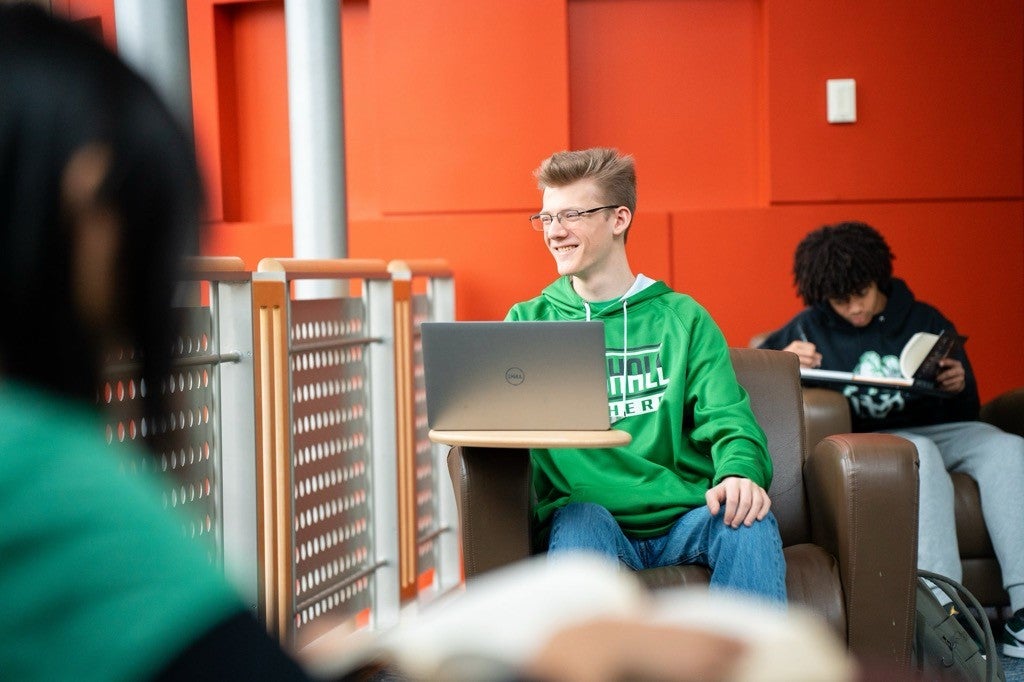All programs in the School of Art & Design are housed in the College of Arts and Media with the exception of Art Education, which is housed in the College of Education.
The Foundation Program prepares students for entry into their chosen artistic discipline. Courses teach concepts and terminology as well as pertinent techniques. The sequence culminates with Foundations Review where each student presents work to a faculty panel and prepares and exhibition in one of our galleries. You will utilize the skills you develop in the Foundations sequence throughout your artistic career.
Bachelor of Arts: BA degree emphases
The Art Education area of study prepares students for teaching art in elementary and secondary settings. Students complete foundation courses in general studies, education and in art and design. The art education program of study provides students with a strong studio foundation. Courses in the School of Art & Design include: drawing, painting, graphic design, photography, sculpture, and ceramics. Students also complete courses in art history and art education methods
The School of Art and Design offers the Bachelor of Arts (B.A.) in Art with areas of emphasis in Visual Art and Design and in Art History. The Art History emphasis offers a wide variety of topics from an overview of global art history to specialized courses from antiquity through the contemporary era.
Visual Art and Design (Catalog link)
The B.A. in Visual Art and Design best suits students who wish to combine studio art and a minor or second degree in another discipline. Students in this emphasis can focus their study in an emphasis area, or choose a more general path. This degree pairs well with a second major in Art Education.
Bachelor of Fine Arts: BFA degree emphases.
These emphases give students a studio school education with 73 to 75 credit hours in art.
Ceramics focuses on the study of traditional formation processes within an atmosphere that promotes material exploration and experimentation. Students are encouraged to develop expertise with both the elements of craftsmanship and developing a strong conceptual voice within one’s work. Critical inquiry of materials and methods is promoted as well as an encouragement for interdisciplinary practice. An understanding of ceramics history and its relationship to contemporary technologies creates a foundation for creating in the Ceramics studio.
Fibers concentrates on the exploration of fibers as a means of individual expression, and exploration of sculptural, architectural, and functional possibilities in two and three-dimensional work. Students learn fundamental techniques such as weaving, dyeing, sewing, pattern making, textile printing, and fiber sculpture. Through the projects, students gain critical thinking, problem solving, history, and contemporary art practice. Fibers courses incorporate both traditional and contemporary methods of textile products and an interdisciplinary approach among other media as well as technology in the productions.
Graphic Design is a dynamic, rewarding and challenging discipline to study. Graphic Design students work in an engaging environment where technical and conceptual problems are continuously presented before them in order to flourish in a globally competitive marketplace. Through the practice of solving these problems, students develop their own individual strengths, gain social and historical context, make connections between disciplines, as well as develop a personal portfolio of work.
Painting is firmly based on well-organized practice with inventive use of tradition. Clear guidelines cultivate reflection with intuition and discipline with craft. Additional procedures give the artist true freedom to express anything in color. The individual approach begins to vary as students gain skills and analytical experience. Advanced painters often discover completely new and unexpected imagery. This is one of the strongest aspects of this painting program: the imagery advances independently and becomes unique to each artist.
The photography area offers students a broad experience in photographic practice and processes to create challenging and stimulating images. Through extensive studio critiques, students and faculty discuss aesthetic choices and possibilities to make the most effective work possible. The photography facilities and curriculum support a hybrid approach to the medium that seamlessly blends digital and analog processes. Through a combination of hands-on experience, classroom instruction, and individualized feedback, students will develop the necessary skills to pursue various career paths.
Printmaking offers a wide range of traditional and innovative experiences. Students are exposed to contemporary approaches utilizing printmaking techniques for the development of ideas and art on and off paper in a healthy environment. Beginning and advanced classes concentrate on the investigation of form and content as it relates to printmaking processes in intaglio, lithography, relief, serigraphy, letterpress, and papermaking. An extensive range of rare letter type is available to support book arts.
In the Sculpture emphasis, we think conceptually, work in an interdisciplinary way, experiment readily, and form a deep skill set in a wide range of materials using numerous processes. Our students become adept in the wood and metal shops along with becoming proficient in a number of computer technologies to aid in construction. Outside of traditional sculpture, we experiment with video and sound installations, performance, social practice, public art, and aspects of post-studio artmaking. All these ways of making demand critical thinking skills to invent creative solutions. In addition to extensive hands-on work, students can expect to get an in-depth understanding of contemporary sculpture and the artists who are expanding the field.
The Studio Art Emphasis is different from the other B.F.A. emphasis areas by allowing students more course options, encouraging working across disciplines, and creating a more open curriculum that reflects contemporary art practice. Students can design their own curriculum in coordination with their academic advisor.
